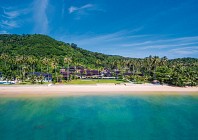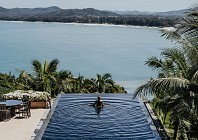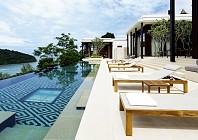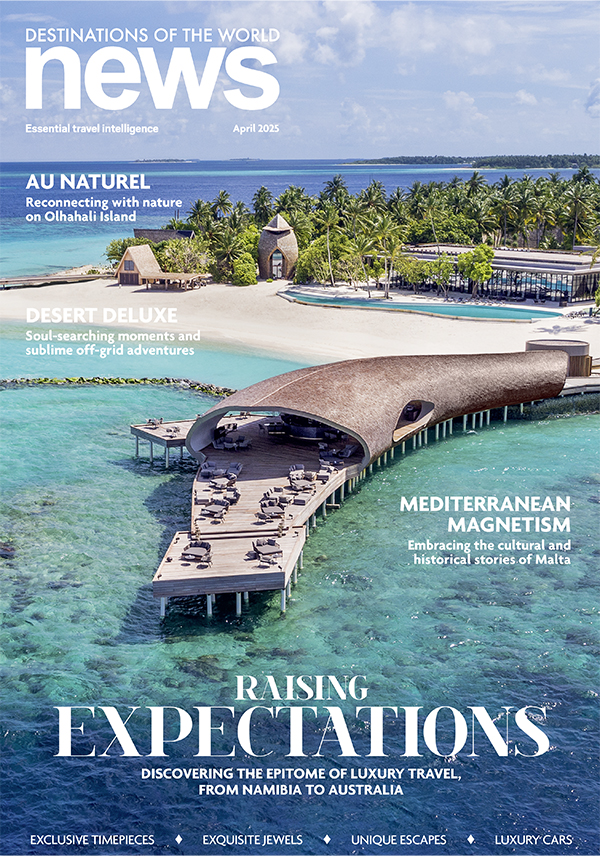“This building has no windows, perfect for making chocolate!” Kristian Levinsen chortles whilst breaking apart a cacao husk between his fingers. The irony of learning about (and tasting) artisanal Thai chocolate in a humid room once used to manufacture ice cubes isn’t lost on our group of four. Levinsen is the hands-on co-owner of Siamaya; one of a raft of independent companies contributing to Chiang Mai’s culinary renaissance.

Far more than a gateway to its namesake province’s northern highlands, the mountain-cradled city of Chiang Mai is a destination unto itself, and a delicious one at that. With bountiful produce, forward-thinking chefs and a growing appetite for plant-based haute cuisine, Thailand’s second city is finally stepping out of the shadow of its culinary capital. In 2020, Michelin added Chiang Mai to its coveted (Thailand) guide for the very first time.

Tucked down a soi (alleyway) in the city’s silversmithing Haiya area is Levinsen’s chocolate factory. It’s part of a former ice-making warehouse reborn as a cultural centre called The Weave Artisan Society that’s home to artisan cafes and stores. A portmanteau of ‘Siam’ (Thailand’s historical name) and ‘Maya’ (the origin of chocolate), Siamaya was one of the early pioneers of Northern Thailand’s boutique bean-to-bar scene, Levinsen explains. Chocolate cultivation in this tropical south east Asian country was more-or-less unheard of until three decades ago. Made with responsibly sourced cacao from family-owned farms in neighbouring Lampang province, flavours range from the exotic (think ‘Thai coconut curry’) to the hyperlocal, like ‘hilly coffee and pomelo’.
Their two-hour-long workshops are an opportunity to see Siamaya’s inner workings; from winnowing the beans to tempering and mould making (the tastiest part!). After sprinkling my almost-set bars with crystallised ginger and dried rose petals, they’re bundled into the fridge, emerging glossy-sheened 15 minutes later.

Siamaya’s bespoke bars happen to be displayed in all their hand-wrapped glory in the lobby of Meliá Chiang Mai: the city’s first 5-star property to open post-pandemic. In the spirit of its Spanish DNA, the hotel’s vast foyer – crowned ‘Best Hotel Lobby Interior Thailand’ at the Asia Pacific Property Awards recently – is washed in sunny Mediterranean hues. But it’s also refreshingly rooted in place. Floor-to-ceiling teakwood panels are engraved with a contemporised tung motif, whilst its striking central sculpture is a tribute to the province’s silverware village of Wua-Lai.

More culturally-infused design can be found 21 floors up in the hotel’s executive Level Lounge. It’s housed in the property’s sleek skyscraper along with 43 rooms and suites, with the hotel’s remaining mountain and city view rooms nestled in the adjoining seven-storey pedestal building. Mélia’s VIP Level experience includes a dedicated concierge service, late check-out, access to a private meeting room, all day snacks and early evening cocktails and canapés. I check-in under sculptural ceiling lights inspired by the bamboo ribs of parasols – a homage to Chiang Mai’s Bo Sang Umbrella Village and its centuries-old umbrella craft.

There are no rain clouds hanging over The Level’s adjoining mountain-view restaurant. Christened Mai, it’s helmed by award-winning chef Suksant Chutinthratip, who’s manned the kitchens of The Peninsula Bangkok and Raffles Singapore. Described as Spanish-Thai fusion fare, chef Billy’s (as he’s affectionately known) fine dining tasting menu has one caveat: some hand-to-mouth-eating is required! Bite-sized appetizers like ‘pomelo and fluffy fish salad in betel leaf’ dance on your tongue, whilst a cake baked from overripe bananas is ambrosial. The waste-free-dessert honours the hotel’s 360 cuisine program, whose nerve centre is ORI9IN: a 350-acre organic farm located a one-hour drive north.

The next day I pay a visit as part of one of Mélia’s signature excursions, accompanied by Chef Billy. “This is my superfood breakfast!” he exclaims, whilst picking a bunch of antioxidant-rich gurmar and indigenous kale that he likes to wok-fry and fold into scrambled eggs. The kale is one of 40 vegetables that ORI9IN grows alongside 10 types of edible flower and non-natives like padrón peppers and thyme. On a scented stroll through their “herb pharmacy”, Farm Manager Donchai Jamekha reveals that the farm – co-founded by double-Michelin-starred-chef-turned-sustainable-farmer James Noble – employs 10 local families. An edible highlight is plucking sun-ripened green Japanese Tomatoes (sprayed with nothing more than wood vinegar) straight off the vine. The rest are boxed up for Mélia’s Mediterranean restaurant’s tomato and mozzarella salad, the leftovers of which will be returned (along with 75kg of food waste per week) to the farm as fertiliser.

Swapping ORI9IN’s hand-planted lemon groves for the city’s hand-built brick medieval walls, I make a beeline for the city’s imposing Tha Phae Gate. A replica of the 13th-century original, it marks the eastern entrance to Chiang Mai’s fortified ruined ramparts, or at least what’s left of them. Its better-preserved, tree-shaded moat encloses the square-shaped Old City that’s home to some 300 ancient wats (temples). Nearby and fanning out for two blocks in every direction from Chang Khlan Road and Loi Khro Road intersection is Chiang Mai’s spirited Night Bazaar, peddling everything from bamboo rice boxes to Muay Thai shorts.

I reward my market-athon efforts with a classic Spanish cocktail from the city’s loftiest rooftop bar: Mélia’s Mai the Sky Bar. Capping Chiang Mai’s original high-rise and soaring 22 floors over the city’s kayakable Ping River, you can eye one of the kingdom’s holiest sites from here on a clear day. The next morning, I make a pilgrimage to the said gilded temple and its namesake 1,685-metre-high rainforest-carpeted peak: Doi Suthep, that’s reached via a road that snakes 10-miles from the city centre. Trust me when I say the views are more than worth climbing the sacred site’s 300-something sea-serpent-guarded steps for!

Nestled at the mountain’s foot is the region’s only forest temple, established by the Lanna Kingdom’s founding monarch. Steeped in spirituality and tranquility, 700-year-old Wat Umong’s frangipani-scattered grounds contain catfish-filled ponds, a Sri Lankan-style stupa and trees strung with Buddhist proverbs. Inside, its cooling brick-clad tunnels are adorned with shrines and faded murals from the Lanna Dynasty which ruled over Northern Thailand from the 13th to 16th centuries. In striking distance from here is my second stylish check-in: Aleenta Retreat Chiang Mai. Opened in April, the 44-room all-teak temple to clean living is the third Aleenta property launched by luxury Thai-owned Akaryn: the country’s first hotel group to phase-out single-use plastic.

The very definition of hyperlocal, I’m welcomed with a drink blended from lemongrass, pandan and betel leaf plucked straight from its onsite garden, that’s sweetened with wild tamarind honey from neighbouring hives. A masterful mash-up of modern and traditional, century-old teakwood stilted Thai dwellings and all-white four-storied buildings enwrap the hotel’s tree-shaded courtyard pool. Guests are immersed in nature from the off. QR-coded plaques reveal the facts and folklore behind flora like star apple, and longan (lamyai in Thai) that’s one of the oldest trees on the property and frames the sun-dappled spa. Meanwhile, the property’s bi-levelled latticed ‘higher purpose room’ (which hosts daily yoga classes) and pillared garden restaurant, embrace Thai’s love of indoor-outdoor living.

The air sticky with an incoming downpour, I resolve to refresh with a dip in my one-bedroom pool residence. Inside it’s all dark lacquered wood floors, copper fittings and bold splashes of imperial red and apricot orange. Most eye-catching is the unique wall art. Hung above my bed’s woven headboard is a framed hand-embroidered skirt worn by the province’s hill tribes, who have their own distinct language and culture.

One such tribe harvests the sustainably-sourced rice served at zero-waste Blackitch Artisan Kitchen. An eight-minute taxi ride from the hotel, the lauded restaurant is located in Chiang Mai’s trendy Nimmanhaemin Road neighbourhood, otherwise known as ‘Coffee Street’. Festooned with jars of fermented and pickled delicacies, stepping into its ground-floor entrance hints of what’s to come. With just 16 covers, the upstairs dining room may be small, but former-civil-engineer-turned-self-taught-chef Phanuphol “Black” Bulsuwan’s seasonally led, omakase-style tasting menu is anything but. Each artfully plated dish – from the ‘wrap and roll’-style King mackerel with local river seaweed to the slow-cooked beef tongue (prepared over several days) – is served with a side of storytelling courtesy of Black or a member of his team. As well as using meat from locally reared black pigs and organic sunflower-fed Thai cattle, the locavore trailblazer makes almost everything from scratch down to the ‘deconstructed’ soy sauce. Not only is Black passionate about promoting the mind-boggling diversity of Thai cuisine, but also harnessing the region’s ancestral culinary know-how.

Another foodie address championing local wisdom and produce is teahouse-cum-shop: Monsoon Tea, where I get my caffeine fix the following morning. Located in the lively riverfront district of Chang Moi, it specialises in serving ‘forest-friendly’ tea from Northern Thailand. In contrast to their domesticated large-scale plantation cousins, the indigenous tea that fills these chic cups has been grown harmoniously with nature; without pesticides, irrigation systems, fertilizers, and crucially, without razing any precious forest.

I fill my boots with bagged, hand-picked Lahu Yellow and order an iced lychee oolong to go, trading tea drinking for trawling the open studio-shops of a unique artist village. Founded by a local ceramicist, Baan Kang Wat is situated just off Suthep Road near to Doi Suthep-Pui National Park. You can attend workshops like woodcut printing and organic soap making or enjoy haggle-free shopping for one-off gifts like pom-pom sandals and elephant music boxes. When you’re done threading through its leafy laneways, take a rest in the meditative central amphitheatre – a perfect spot to revive with young coconut ice cream.

There’s more serenity in store for me at Aleenta (located a five-minute drive away), where I retreat to its two-storied Ayurah Wellness Centre: the resort’s lodestone. Reflexology guru and Qi-Gong master Khun Alfa greets me not with a hand shake but a hand reading! Rather than foretelling my future, Alfa studies my palm to get a picture of my overall health, which will inform any subsequent treatments. After sipping on a healing bael fruit tea, I’m escorted upstairs for a 90-minute blissful Four elements ‘Naam’ (water) massage, which uses warm aromatherapy oils to manipulate my meridian points.

The resort’s customised spa therapies are complemented by (optional) nutritionist-led meal plans, which, as I come to learn later that evening, are as ethical as they are salubrious. The smoked trout starter, for example, has been sourced through a non-profit called the Royal Project. Launched by the late King Bhumibol Adulyadej in 1969, it was established to counter Northern Thailand’s opium trade by providing an alternative income stream for hill tribe villagers.

My last supper begins with a guilt-free non-alcoholic gin on the sweeping balcony of the hotel’s more informal dining venue: 1892 Bar. Overlooking Aleenta’s spiritual blessing garden, the Lanna-style house has been upcycled from a 200-year-old stable building together with golden teakwood found abandoned on the site. Chef Kittipong Thepka turns out Thai izakaya bar bites like vegan Khao soi gyoza, and surprisingly lean Chiang Mai buffalo tenderloin tartare, that’s quite literally seared into my memory. Celebrating not only the region’s extraordinary terroir but the boundless creativity of the people who call it home, the meal makes for a fitting finale to my Chiang Mai culinary odyssey…











